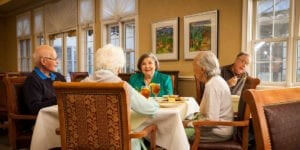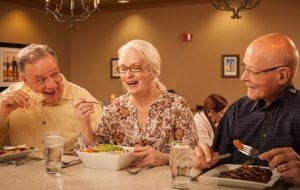
At some point in the last several months, you decided to move into a senior community. You signed the contract, put your home on the market, hired movers, and possibly had a garage sale. You took advice on how to plan your move to have as little stress as possible. Now, you’re sitting in a new apartment in a new community. You’ve unpacked all your boxes – or almost unpacked. It seems like you have met every staff member in a matter of a couple of days. You have a resident handbook, a resident directory, and a resident activities calendar sitting on your coffee table.
Now what?
Outside your door is a community full of opportunity. For some, it’s easy to dive in head first from day one. For others, it takes a little time to get acclimated. Either way is completely fine.
We recently spoke to some residents to get their insights into what life is like after they move into a senior community – Peg and Stan, Anne and Ben, Martie, and Joe.
Dining Room
While your apartment has its own kitchen, take advantage of the community’s dining room as a way to get to know people. However, if you’re a bit shy or single, walking into a dining room filled with strangers may seem a little overwhelming. Nellie admits that it took her a little time to get comfortable in the dining room. “It was the most difficult part for me. But another resident took me under her wing and began introducing me.”
Some communities may offer a table reserved for new residents. A welcoming committee may pair you with a resident to serve as your host to help you get to know the lay of the land. Martie recalls her first trip to the dining room with her daughter. “The word must’ve gotten out, for many came by our table and welcomed me to my new home,” she remembers. “I was assured I would have many new friends.”
If your community offers breakfast, start by going each morning. “Breakfast is a smaller group of residents,” Peg says. “It’s a good way to get to know people.”
For single male residents, ask if the dining room offers a men’s only table. Joe says he really enjoys sitting with his friends at their table. “We just talk about our days and what’s going on,” he says.
Outings and Activities
There’s so much that goes on throughout the week in senior communities that it’s difficult not to find something that interests you. If you’re a bit of an introvert, find one activity that appeals to you and go. After you’ve gone a few times and are acquainted with a few of the residents, try another activity or even go on an outing. Both Anne and Ben stress that it’s okay to take your time. “Be patient with yourself,” Anne offers.
On the other side of that coin, some people are ready to be involved in everything. Stan and Peg wanted to begin taking part in what was available from the beginning. “By going on all the outings it helps you get ,to know residents and staff. Going to everything is a plus,” they note.
As a single man, Joe suggests that you get involved immediately. “It relieves some anxiety about being by yourself.”
The important thing to remember is that you are in control when it comes to your level of involvement in activities, outings, or even going to the dining room. Do what’s comfortable for you. It’s also important to understand the value of being active. Living in a senior community may take some getting used to, but it will prove to be worthwhile. As Joe says, “It’s extended my life because I’m more active, have no worries, and I’m gaining new friends.”
Ready to make a move? We’ve got the perfect moving checklist. Download now!
Download our free de-cluttering guide.



